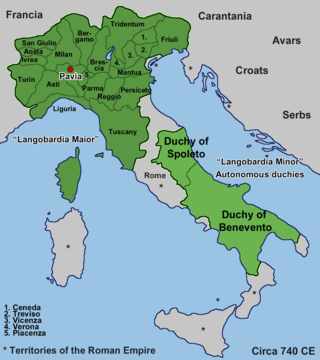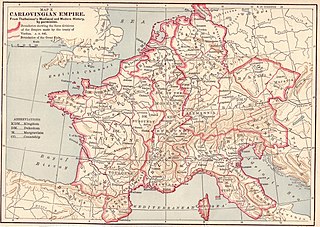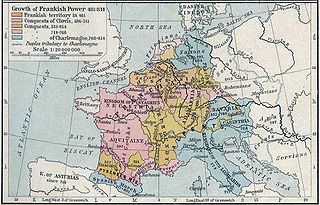Related Research Articles
The 610s decade ran from January 1, 610, to December 31, 619.
The 590s decade ran from January 1, 590, to December 31, 599.

Year 610 (DCX) was a common year starting on Thursday of the Julian calendar, the 610th year of the Common Era (CE) and Anno Domini (AD) designations, the 610th year of the 1st millennium, the 10th year of the 7th century, and the 1st year of the 610s decade. The denomination 610 for this year has been used since the early medieval period, when the Anno Domini calendar era became the prevalent method in Europe for naming years.

Year 611 (DCXI) was a common year starting on Friday of the Julian calendar. The denomination 611 for this year has been used since the early medieval period, when the Anno Domini calendar era became the prevalent method in Europe for naming years.
Grimoald or Grimwald (†671) was a 7th-century King of Italy, ruling as Duke of Benevento from 647 to 662, and then as King of the Lombards from 662 until his death in 671.
Radoald was the duke of Benevento from 642 to his death in 647. His elder brother, Aiulf, was mentally unstable and Radoald and their younger brother Grimoald served as regents. Radoald and Grimoald were brothers and younger sons of Gisulf II of Friuli and Romilda of Friuli. They were adopted sons of Arechis I of Benevento, of whom Aiulf was a natural son.
Gisulf II was the Duke of Friuli from around 591 to his death. He was the son and successor of Grasulf I of Friuli.
Tasso was the joint Duke of Friuli with his younger brother Kakko from their father's death (611) to their own. Their father was Gisulf II and their mother Romilda of Friuli. In or around 611, Gisulf was killed fending off an Avar invasion.

Theodo, also known as Theodo V and Theodo II, was the Duke of Bavaria from 670 or, more probably, 680 to his death. It is with Theodo that the well-sourced history of Bavaria begins. He strengthened his duchy internally and externally and, according to the medieval chronicler Arbeo of Freising, he was a prince of great power whose fame extended beyond his borders.
Eric was the Duke of Friuli from 789 to his death. He was the eldest son of Gerold of Anglachgau and by the marriage of his sister Hildegard the brother-in-law of Charlemagne.
Garibald II (585–625) was Duke of Bavaria from 610 until his death. He was the son of Tassilo I.
Tassilo I was Duke of Bavaria from 591 to his death. According to Paul the Deacon, he was appointed as Bavarian rex by Childebert II, Frankish king of Austrasia, in 591, ending the war with the Franks. The war began during the reign of Tassilo's predecessor, Garibald I, when Garibald concluded a marriage alliance with the Lombards. We do not know whether Garibald died or was deposed. Nor do we know Tassilo's exact relationship to Garibald, though we can assume Tassilo was a close relation if not his son. The fact that Childebert named Tassilo duke shows Frankish control over the Bavarian state.

Garibald I was Duke of Bavaria from 555 until 591. He was the head of the Agilolfings, and the ancestor of the Bavarian dynasty that ruled the Kingdom of the Lombards.
Lupus was the Duke of Friuli from between 660 and 663 to his death around 666.

The Duchy of Friuli was a Lombard duchy in present-day Friuli, the first to be established after the conquest of the Italian peninsula in 568. It was one of the largest domains in Langobardia Major and an important buffer between the Lombard kingdom and the Slavs, Avars, and the Byzantine Empire. The original chief city in the province was Roman Aquileia, but the Lombard capital of Friuli was Forum Julii, modern Cividale.

The March of Friuli was a Carolingian frontier march, established in 776 as the continuation of the Lombard Duchy of Friuli, established against the Slavs and Avars. It was ceded to the Duchy of Bavaria as the March of Verona in 952. Its territory comprised parts of modern-day Italy, Slovenia and Croatia.

The March of Pannonia or Eastern March was a frontier march of the Carolingian Empire, named after the former Roman province of Pannonia and carved out of the preceding and larger Avar March.

The siege of Trsat was a battle fought over possession of the town of Trsat in Liburnia, near the Croatian–Frankish border. The battle was fought in the autumn of 799 between the defending forces of Dalmatian Croatia under the leadership of Croatian duke Višeslav, and the invading Frankish army of the Carolingian Empire led by Eric of Friuli. The battle was a Croatian victory, and the Frankish commander Eric was killed during the siege.
Gerold was a franconian nobleman who served the Frankish King, Charlemagne, as Margrave of the Avar March and Prefect of Bavaria in what is now South-Eastern Germany. Gerold played a significant role in the integration of Bavaria into the Frankish Kingdom during Carolingian expansion in the late 8th, and early 9th centuries. Gerold both aided the continuity of Agilofing rule of Bavaria, as well as took steps to integrate Bavarians into the wider scope of the Frankish Kingdom. Gerold was related both to the Agilofing family, the ruling class of Bavaria, as well as the Carolingian family. The Agilofings had ruled Bavaria since Duke Garibald I in 548. Gerold was born into the Agilofings, and his sister Hildegard was married to Charlemagne in 771. From these familial connections, he was appointed Prefect of Bavaria following the deposition of Duke Tassilo III in 788. Gerold was heralded as a superb military commander, giving rise to his promotion to Prefect as a defender of the eastern border of the Frankish Kingdom. In 799, Gerold is said to have fallen in battle against the Avars, shortly after the same Avars killed his ally, Eric, Duke of Friuli, through treachery.

The Avar Wars were fought between Francia and the Avar Khaganate in Central Europe from 788 to 803, and ended with the Frankish conquest of the khaganate's western regions. The first conflicts between the Avars and the Franks occurred in the 560s, shortly before the Avar conquest of the Pannonian Basin. Armed conflicts between the two powers were not unusual during the following centuries.
References
- ↑ Hodgkin, Thomas. Italy and Her Invaders: The Lombard kingdom, 600-744, Clarendon Press, 1916, pp. 51-53
- ↑ Lisa M. Bitel: Women in Early Medieval Europe, 400-1100 , CAMBRIDGE UNIVERSITY PRESS
- ↑ Dick Harrison: Krigarnas och helgonens tid: Västeuropas historia 400–800 e.Kr. ISBN 91-518-3897-4